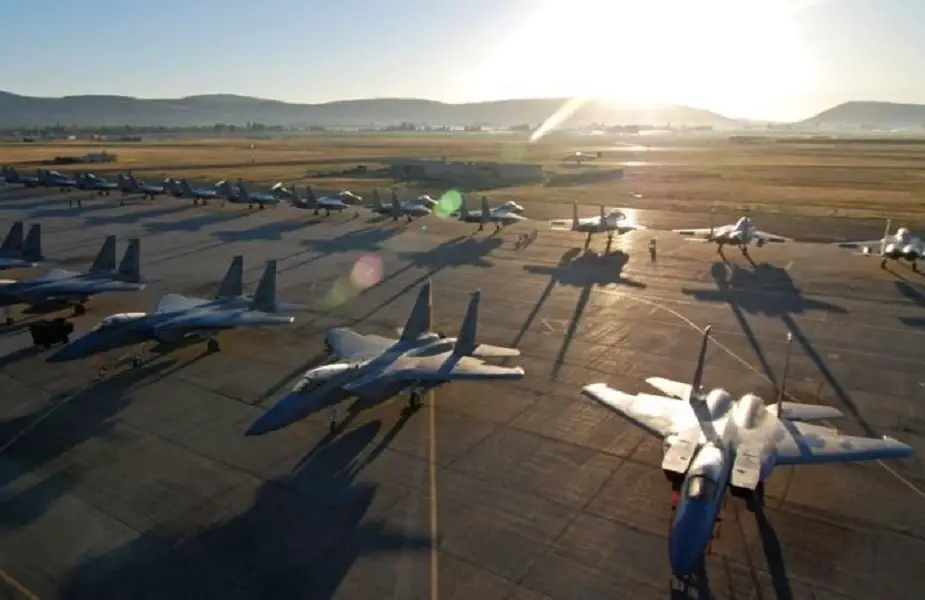Breaking news
F-15C fleet prepares to stand down after 50 years of vigilance.
For 24 years the F-15 Eagle has roared over the city of Klamath Falls, Ore., flying countless training missions and supplying air superiority pilots to the U.S. Air Force. This aircraft is special in its own right boasting an undefeated record in combat and a service life reaching back 50 years—a remarkable lifespan for a fighter aircraft. Those days are nearing their end however as the retirement of the aircraft is fast approaching. So, where will they go?
Follow Air Recognition on Google News at this link
 September 11, 2016 saw eight jets leave the 173rd Fighter Wing at Kingsley Field for the last time as they transit to Israel in the first active ramp-to-ramp transfer of aircraft under the purview of Foreign Military Sales (FMS). Those aircraft continue to service the Israeli Air Force today (Picture source: U.S. Air National Guard)
September 11, 2016 saw eight jets leave the 173rd Fighter Wing at Kingsley Field for the last time as they transit to Israel in the first active ramp-to-ramp transfer of aircraft under the purview of Foreign Military Sales (FMS). Those aircraft continue to service the Israeli Air Force today (Picture source: U.S. Air National Guard)
It turns out, a number of different places—the sunny Arizona desert, Israel, NASA, and some are going on to fame and notoriety of sorts…
September 11, 2016 saw eight Kingsley F-15s transferred directly to the Israeli Air Force where they are still flying today—the first-ever active ramp-to-ramp transfer of aircraft.
“Several of our jets were scheduled for retirement and they were going to be taken to the bone yard; one of the options that came up was FMS [Foreign Military Sales],” said U.S. Air Force Lt. Col. Matthew Thomas, the detachment commander for the deployment at the time.
Another aircraft was transferred to the National Aeronautics and Space Administration, better known as NASA, where it will be a part of their chase plane program helping capture research data for their airborne platforms.
“We transferred aircraft 78-0515 this last July,” said Senior Master Sgt. Jay Bosse , a maintenance management production scheduler.
Some Kingsley aircraft go on to become a “rock stars”—figuratively speaking—they will transfer to the National Museum of the United States Air Force are subsequent be loaned to a community for public display. Once a city or town expresses an interest and are approved, they go on a waiting list to receive a piece of Air Force history. With the retirement of the Eagle fleet that list is shrinking rapidly as the museum transfers jets to communities around the country.
Kingsley Field has three of these jets, an A-model F-15 that flew here, which was transferred to the museum upon its retirement and subsequently put on-loan to the base for the static display. Additionally, there is an F-4 Phantom II and an F-16 Fighting Falcon on display, which both flew over the base and region in their days of active service.
The National Museum of the United States Air Force has also approved one Kingsley Field F-15 to transfer to the local community, Klamath Falls, Ore., for public display.
Finally, many jets are retiring to sunny Arizona. Commonly known as “The Boneyard”, the Aerospace Maintenance and Regeneration Group, takes jets and mothballs them in the southwest desert.
Like legions of retirement age Americans the jets enjoy the low humidity and lack of snow or rain for their later years. It’s an environment that helps preserve the aircraft in the event they should be called back to service.
This year the 173rd Fighter Wing has seen the retirement of 11 aircraft and will continue to see aircraft move on to their golden years for another year or so.
 Since 1998 the 173rd Fighter Wing at Kingsley Field, Klamath Falls, Ore., has flown the F-15 Eagle both A/B and C/D models, which are now nearing their eventual retirement. The wing retired 11 airframes this year and expects to see the majority of the fleet retiring in the next two years (Picture source: U.S. Air National Guard)
Since 1998 the 173rd Fighter Wing at Kingsley Field, Klamath Falls, Ore., has flown the F-15 Eagle both A/B and C/D models, which are now nearing their eventual retirement. The wing retired 11 airframes this year and expects to see the majority of the fleet retiring in the next two years (Picture source: U.S. Air National Guard)


























